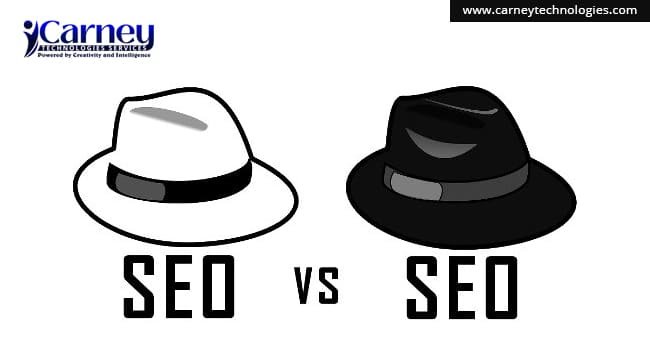Uncover the secrets of White Hat and Black Hat SEO strategies in this must-read comprehensive guide for all digital marketers.

Image courtesy of via DALL-E 3
Table of Contents
Introduction: What is SEO?
Search Engine Optimization, commonly known as SEO, plays a crucial role in helping websites be discovered on the vast landscape of the internet. Imagine it as a secret code that helps search engines like Google understand what your website is all about and where it should appear in search results.
Why SEO Matters
SEO matters because it acts as a roadmap for search engines, guiding them to your website when someone types in a query related to your content. In simple terms, SEO helps your website climb the ladder to the top of search result pages, making it easier for people to find you.
Good vs. Bad SEO
When it comes to SEO, there are two main camps: ‘White Hat’ and ‘Black Hat’. Think of it like the good guys versus the bad guys in a movie. The rest of this article will dive into the details of these two approaches and help you understand their impact on your website’s success.
What is White Hat SEO?
White Hat SEO is a way to improve website rankings using ethical and safe practices. It focuses on creating quality content, conducting keyword research, building links, and enhancing user experience to boost a site’s visibility on search engines like Google.
Content Quality
Creating great content is at the heart of White Hat SEO. When websites offer valuable information that is helpful to visitors, they are more likely to attract and retain an audience. Google also rewards sites that provide high-quality content by ranking them higher in search results.
Keyword Research
Keyword research involves finding the right words and phrases that people are searching for online. By incorporating these keywords into website content, it becomes more relevant to search queries, increasing the chances of appearing in search engine results.
Link Building
Link building is another essential aspect of White Hat SEO. By linking to reputable websites and earning backlinks from them, a website can establish its authority and credibility. Quality links from trusted sources can improve a site’s visibility and rankings.
User Experience
User experience plays a crucial role in White Hat SEO. Websites that are easy to navigate, fast to load, and provide valuable information create a positive experience for visitors. This, in turn, encourages users to stay longer on the site, reducing bounce rates and improving search engine rankings.
What is Black Hat SEO?
Black Hat SEO involves using unethical and deceptive techniques to try to manipulate search engine rankings quickly. These practices can lead to penalties from search engines and damage a website’s reputation in the long run.

Image courtesy of www.linkedin.com via Google Images
Keyword Stuffing
Keyword stuffing is the practice of overloading content with irrelevant keywords in an attempt to boost rankings. However, this can make the content unreadable and unpleasant for users, resulting in a poor user experience.
Cloaking
Cloaking is a tactic where different content is shown to search engines and users. This misleading practice tricks search engines into ranking the page higher, even though the actual content may not be relevant to the user’s search.
Link Farms
Link farms are networks of websites created solely for the purpose of linking to each other to artificially inflate rankings. This spammy practice is discouraged by search engines as it does not provide valuable content to users.
Hidden Text
Hidden text involves hiding keywords or links on a webpage by making them the same color as the background, making them invisible to users but still readable by search engine crawlers. This dishonest practice can result in penalties from search engines.
Comparing White Hat and Black Hat SEO
When it comes to optimizing a website for search engines, there are two main approaches: White Hat SEO and Black Hat SEO. Let’s take a closer look at how these two strategies differ in terms of ethics and outcomes.
Short-Term vs. Long-Term
White Hat SEO focuses on creating high-quality content and following search engine guidelines. While this may take longer to see results, the benefits are long-lasting. On the other hand, Black Hat SEO employs tactics that can yield quick results, but these gains are often short-lived and can result in penalties from search engines.
Risks and Penalties
Using Black Hat SEO techniques comes with significant risks. Search engines like Google have strict algorithms in place to detect unethical practices, and websites that engage in Black Hat SEO may face penalties such as being banned from search engine results. On the contrary, White Hat SEO ensures compliance with search engine guidelines, reducing the risk of penalties.
Trust and Reputation
Building trust and a good reputation is crucial for the long-term success of a website. White Hat SEO focuses on establishing credibility with both search engines and users by providing valuable content and following ethical practices. This trust can lead to increased traffic, higher rankings, and a positive brand image. In contrast, Black Hat SEO undermines trust and can tarnish a website’s reputation, ultimately hindering its growth and success.
Why Should You Choose White Hat SEO?
Choosing White Hat SEO methods is like playing by the rules in a game. By following ethical practices, you build trust not only with search engines like Google but also with the visitors who come to your website. Just like how honesty is the best policy, using White Hat techniques shows others that you can be trusted.
Better User Experience
Imagine visiting a website that is cluttered, hard to navigate, and filled with annoying pop-up ads. Would you want to stay on that site for long? Probably not. With White Hat SEO, you focus on creating a better user experience by providing valuable content and making your website easy to use. This encourages visitors to stay longer, come back, and even recommend your site to others.
Long-Term Benefits
Think of White Hat SEO as planting seeds in a garden. It takes time for those seeds to grow into beautiful flowers, but once they do, they bloom year after year. Similarly, White Hat methods may take longer to show results compared to Black Hat shortcuts, but the benefits are long-lasting and stable. Building a strong foundation for your website with ethical practices ensures sustained success in the long run.
Real-Life Examples of White Hat SEO
One great example of a popular blog that successfully used White Hat SEO practices to gain readers and followers is “Healthy Eats Daily.” This blog focused on creating high-quality, informative content about healthy eating habits and recipes. By conducting thorough keyword research and incorporating relevant keywords naturally into their articles, they were able to attract a targeted audience interested in health and nutrition. Additionally, they engaged with their audience through social media, building a community around their blog.

Image courtesy of www.carneytechnologies.com via Google Images
Example 2: An Online Store
Another excellent case study of White Hat SEO in action is an online store called “TechGear Co.” This e-commerce site dedicated to selling the latest tech gadgets implemented ethical SEO strategies to improve its rankings and boost sales. By regularly updating their product descriptions with keyword-rich content, providing valuable information to customers, and earning backlinks from reputable technology review websites, TechGear Co. saw a significant increase in website traffic and conversions. Their focus on user experience, including easy navigation and secure payment options, also contributed to their success.
Real-Life Examples of Black Hat SEO
Black Hat SEO techniques may promise quick results, but they often come with severe consequences. Let’s explore some real-life examples of websites that have faced the repercussions of using unethical methods to boost their rankings.
A Penalty Story
One notorious example of Black Hat SEO tactics leading to severe penalties is the case of a popular website that employed keyword stuffing and hidden text to manipulate search engine rankings. Despite seeing a temporary spike in traffic, the site was ultimately hit with a harsh penalty from Google, causing it to plummet in search results and lose a significant portion of its organic traffic. This penalty not only damaged the website’s visibility but also tarnished its reputation in the eyes of users and search engines.
A Short-Lived Success
In another instance, a website resorted to shady link-building practices, including participating in link farms and purchasing backlinks from low-quality sources to artificially inflate its authority. While these tactics initially led to a rapid rise in search engine rankings and traffic, the success was short-lived. The search engines eventually caught on to the manipulation and penalized the site, banishing it from their results entirely. This swift downfall serves as a cautionary tale about the risks associated with Black Hat SEO techniques and highlights the importance of ethical and sustainable practices for long-term success.
How to Start Using White Hat SEO
Before diving into White Hat SEO techniques, it’s important to assess the current status of your website’s SEO. There are free tools available online that can help you understand where your website stands in terms of optimization. Look for areas that need improvement, such as page load speed, mobile-friendliness, and keyword usage.

Image courtesy of growthrocks.com via Google Images
Step 2: Keyword Research
Keyword research is the foundation of effective SEO. Identify relevant keywords that your target audience is likely to use when searching for content related to your website. Utilize tools like Google Keyword Planner or SEMrush to discover high-traffic keywords that are relevant to your niche.
Step 3: Create Quality Content
Content is king when it comes to White Hat SEO. Focus on creating high-quality, valuable content that addresses the needs and interests of your target audience. Make sure your content is well-written, engaging, and optimized with the keywords you’ve identified.
Step 4: Build Good Links
Link building plays a crucial role in building your website’s authority. Seek opportunities to acquire backlinks from reputable websites within your industry. Collaborate with other website owners, guest post on relevant blogs, and list your website on online directories to build a strong backlink profile.
Step 5: Monitor and Adjust
SEO is an ongoing process that requires monitoring and adjustment. Keep track of your website’s performance using tools like Google Analytics. Analyze the data, identify trends, and make necessary adjustments to your SEO strategy to improve your website’s visibility and rankings on search engines.
Frequently Asked Questions (FAQs) About White Hat vs. Black Hat SEO
Below are some common questions readers might have about the differences between White Hat and Black Hat SEO:
What happens if I use Black Hat SEO?
If you choose to use Black Hat SEO techniques, you might see quick results in the beginning. However, search engines like Google frown upon these unethical practices. If they catch you using Black Hat methods, your website could face severe penalties. This could range from being pushed down in search rankings to even being completely banned from search results. It’s important to remember that the risks of using Black Hat SEO far outweigh the short-term benefits.
How long does White Hat SEO take to show results?
Unlike Black Hat SEO, which promises quick but unsustainable results, White Hat SEO takes time to show its effects. Building a strong foundation through ethical practices like creating quality content, conducting keyword research, and earning backlinks from reputable sites can lead to long-lasting success. While the timeline for seeing improvements with White Hat SEO varies depending on different factors like competitiveness in your industry and the quality of your efforts, it’s essential to remember that sustainable growth is worth the wait.
Can I switch from Black Hat to White Hat SEO?
If you’ve been using Black Hat SEO techniques and want to transition to White Hat methods, it’s possible to make the switch. However, it’s crucial to do so carefully and systematically. Start by identifying and removing any unethical practices from your website. Focus on creating high-quality, relevant content and building genuine relationships for backlinks. It may take time to regain trust with search engines and users, but the long-term benefits of ethical SEO practices far outweigh the risks associated with Black Hat strategies.







